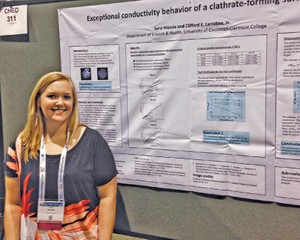
Marianne Robinson, a junior on Main Campus double majoring in English literature and biology, completed her research with Cliff Larrabee, professor of chemistry at UC Clermont, last spring. The project, “Encapsulated Micelles for Targeted Drug Delivery,” found that a particular carrier molecule was very effective at directing drug therapies within environments typical of cancer cells. Robinson, who conducted the study as a participant in the Research Experience for Undergraduate Women (REWU) program — which is sponsored by UC’s Women in Science and Engineering (WISE) — is enthusiastic that the research could have positive benefits for actual cancer patients.
“We are very excited looking forward at the potential that this carrier molecule could have, once modified through future experiments and testing, when implemented in actual drug therapies,” Robinson says.
Another research project completed by recent UC Clermont graduate Timothy Dennison and Larrabee, “Micelle Formation of Hexa (Sodium 10-undecenoate) in Aqueous Solution: Molecular Dynamics”, also focused on a more efficient method of delivering chemotherapy to patients. The project built on research Larrabee had begun while a master’s student at Dartmouth. Dennison traveled to Barcelona in July to present the research at the 6th International Conference on Nanotechnology, Fundamentals and Applications.
Dennison, who was a Post-Secondary Enrollment Option (PSEO) student at UC Clermont, is now studying physics and music at Miami University but misses the close-knit research community at the college. “I’ve realized the value of being able to easily walk across the campus in five minutes and find anyone you need,” Dennison says. “And because just a handful of people are involved in serious research at the college, there is a lot of discussion and interest in your project.”
Dennison and Larrabee also worked with WISE student Jana Monde on a paper titled “Exceptional Behavior of a Clathrate-Forming Surfactant,” which focuses on designing targeted chemotherapy drug delivery systems and has been submitted to the Journal of Chemical Thermodynamics.
Monde, who worked in the UC Clermont lab in summer 2014 and continued her research throughout the 2014-15 academic year, presented the paper at the 250th National Meeting of the American Chemical Society in Boston in August.
Larrabee, who holds a PhD from UC and has taught at the college since 1986, says undergraduate research at UC Clermont College has grown organically, as he realized there was growing interest among his students.
“Thirty years ago, I had six chemistry students — it’s now between 80 and 100 new students every year,” Larrabee says.
“With the increasing number of students, I started to see more who would be successful at any institution in the country. About 10 years ago, some students started asking if they could do research in the lab, so I started an informal undergraduate research program.”
A few years later, Larrabee began partnering with the WISE program to bring female student researchers to campus, but wanted to find a way to open a formal program to all UC Clermont students, regardless of gender. So two years ago, Larrabee spearheaded the Summer Research Experiences for Undergraduates program. Dennison was this year’s selected student, while Monde and Robinson continued the tradition of WISE students conducting research at the college. By tackling real-world questions early in their academic careers, Larrabee believes the program helps bridge theory and practice for his chemistry students.
“If you want to be the next William Shakespeare, you have to start off learning the alphabet first. The first year of general chemistry, you don’t get much beyond being able to spell ‘cat’ and ‘dog’, Larrabee says.
“If you give them a real problem to investigate — fundamental research leading to advances in cancer treatment — you give them a taste of what it’s like to be the next Shakespeare. They’re working with the same types of tools as the recent Nobel Prize winners. It’s a taste of everything that science is all about.”
